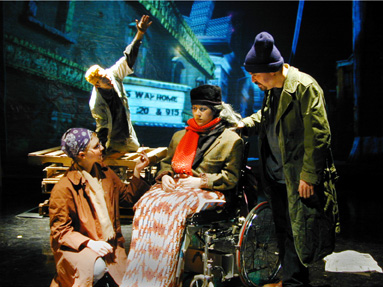
an opera.
Stephen Rush, music.
Michael Rodemer, libretto, set design.
2001.
QT movie -- ten mins. -- 27MB -- click here
Download publicity image above -- 4.5MB: Mac or Zip

an opera.
Stephen Rush, music.
Michael Rodemer, libretto, set design.
2001.
QT movie -- ten mins. -- 27MB -- click here
Download publicity image above -- 4.5MB: Mac or Zip
vidGod combines a dancer, live actors, and singers with computer-generated characters moving in a projected set which is a continuation of the real stage space. Rush’s music is by turns powerful and dark, or playful and teasing, or apocalyptic, as the action of the piece develops. Rodemer’s libretto conjures a dystopian society of the not-so-distant future, where streetpeople develop a cult around the ubiquitous video surveillance cameras. Conflicts arise around characters who articulate their skepticism or lack of it, and with the vidCops who brutally maintain order.
Video cameras already watch much of what we do in public, and public acceptance of this seems high. A politician in Berlin, for instance, declared that no-one has a right to remain unrecognized in public places. And at the 2001 “Super Bowl” football game in the USA, all 70,000 spectators’ faces were scanned via video cameras and compared by computer with the faces of known criminals. Nineteen people could have been arrested, had it not been merely a test. The city of Tampa now employs a similar system in public places.
In a weird way, the “need” for the video cameras can be seen as a need for someone to watch us, making sure we are good. And since God is presumed dead, who should this be, if not the video cameras? Thus, video surveillance takes the place of conscience and makes possible a return to an ethic not of self-responsibility, but child-like subservience and opportunism. The distance from where we now stand to the absurdist vision of this opera seems not so very great.
The set is stark and dark, overseen by video cameras that swivel back and forth while slowly blinking red LED’s signal their functioning. Video monitors and video projectors above and around the stage are linked to the cameras so that the audience can see what the cameras see (these are switched during the performance); Most importantly, rear video projections at the back of the stage add the virtual dancers of the “Herd,” plus a transition where a live character moves into the video realm.
The opera is in great part electronically mediated, employing surveillance cameras, 3D computer-animated sets and virtual dancers, and lasers along with electronic sample players. The music is scored for synthesizers, samplers, turntables, amplified trash cans, brake drums, and hub caps, traditional instruments, and, of course, voices.